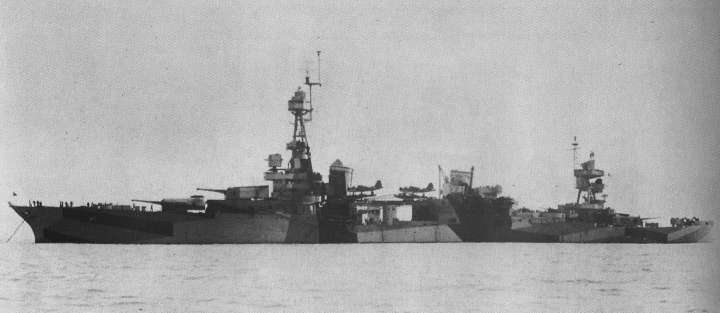

After the beginning of the construction of the Salt
Lake City class, the U.S. Navy seeked to improve upon the design in
several respects. Especially the Bureau of Construction & Repair felt
that certainly, too much had been paid for the ten-gun 203mm battery that
the Salt Lake City class mounted, while armor and sea-keeping among
others had been sacrificed for that. Accordingly, it was suggested to either
build a nine-gun ship mounting three triple turrets, or
an eight-gun vessel with
four twin turrets.
Although the Salt Lake City class as completed was badly underweight,
this was not quite evident when the Northampton class was constructed,
and accordingly, the three-turret ship was adopted since it was capable
of saving weight. This weight and some of the built-in calculated margin
of the Salt Lake City class was used to split the single boiler
room of the previous class and increase the bulkheads protecting the boiler
compartments, at an estimated increase in weight of 200 tons.
The final pre-design scheme presented three turrets, nine guns, and a ship
with higher freeboard and boiler rooms separated by a transverse bulkhead.
The critical desire to save weight also led to the design being stripped
of another quarter inch off the belt, which was rather weak in any case.
Some compensation resulted from the better compartmentalization and the
added and strengthened bulkheads, which improved underwater defences. This
was quite acceptable to the designers, for underwater damage seemed a more
imminent threat to the safety of a heavy cruiser in the late 1920s than
did cruiser gunfire against which belt armor could have been used. At the
same time, however, the
protection against destroyer
gunfire was supposed to be increased so as to achieve protection against
cruiser gunfire -- this, however, was not attempted in the end, as the
construction margin seemed to small.
The Northamptons were the first to implement an important feature
in using bunks instead of hammocks for all of the crew, at the expense
of living room, but the reduced space needed for machinery, a result of
improved oil storage, basically made up for the increased volume needed
for sleeping room. This adoption of the more comfortable crew quartering
was an important feature in a peace-time, volunteer-crewed Navy.
The aircraft arrangements of the Salt Lake City class also were
completely overhauled, giving the Northamptons enough shelter for
the storage of four floatplanes in protection against splinters and main-battery
blast, something the Salt Lake City class lacked.
The secondary armament equalled that of the earlier class with an initial
outfit of four 127mm L/25 AA guns, upped in 1936 to eight, while the initial
six torpedo tubes were removed.
Three ships, CA-26, -27, and -28, were built as division flagships, the
other three as fleet flagships.
The war careers of these ships saw them in much fighting and taking heavy
losses. These careers are omitted here; see the links to DANFS Online,
below, for more information.
Ships in class:
Northampton,
CA-26
Chester,
CA-27
Louisville,
CA-28
Chicago,
CA-29
Houston,
CA-30
Augusta,
CA-31
|
|
Displacements:
Standard: 9050 tons Full: 11.420 tons Length: 182.96m / 600ft 3" Beam: 20.14m / 66ft 1" Draft (Full Load): 5.92m / 19ft 4" Height: ???? / ???? Crew (Officers/Men): ??/????, total 617 Endurance: 13.000nm at 15 knots Speed: 32.5 knots |
|
|
Belt: 95 (Magazines)
- 76mm (Engine & Boiler) / 3.7 - 3"
Deck: 37mm - 25mm / 1.5 - 1" Barbettes: None? Gunhouses: 63 - 37mm / 2.5 - 1.5" Conning Tower: None |
|
|
(As designed):
Main: 9 x 203mm L/55 in three triple turrets, two superfiring forward, one aft Secondary: 4 x 127mm L/25 in four single mounts, two on each side AA: 8 x 12.7mm in single mounts Torpedos: 6 x 533mm in two triple mounts, one on each side Aviation: 4 planes, two catapults |
| (Augusta,
1944):
Main: 9 x 203mm as above Secondary: 8 x 127mm L/25 in eight single mounts, four on each side AA: 24 x 40mm in quad and twin mounts 20 x 20mm in single mounts Torpedos: None Aviation: 4 planes, two catapults |